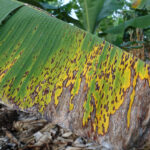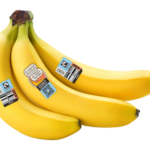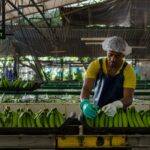Collaboration key to contain Panama Disease comeback

Major banana-producing regions went on alert last week , heeding a warning from the United Nations’ Food and Agriculture Organization (FAO) on the frightening return of Panama Disease.

Photo: www.shutterstock.com
The FAO asked traders and producers to step up their monitoring and prevention efforts for Fusarium oxysporum f. sp. cubense, the soil-borne fungus that propagates Panama Disease and brought the commercial industry to its knees in the 1950s.
Although planted for its resistance, the leading Cavendish variety has fallen prey to a recent Fusarium mutation, dubbed Tropical Race 4 (TR4). This evolved strain of Panama Disease has threatened Asian producers since the 1990s.
Fear now grows that this killer fungus could spread further into Asia, Africa and Latin America, following new detections in Mozambique and Jordan.
Gianluca Gondolini, secretariat of the World Banana Forum, said Latin American in particular will need to implement prevention efforts to protect the livelihood of its banana-producing nations.
"Latin America has three of the world’s biggest exporters, Ecuador, Costa Rica and Guatemala. That poses a threat from a market perspective and has companies and governments on alert because it relates to revenue as well as the livelihood of the people working with banana plantations," Gondolini told www.freshfruitportal.com.
"It could create a similar portrait to what happened in Panama 50 years ago when the entire industry was devastated by Fusarium and all the Gros Michel was replaced with Cavendish."
Although the consequences of Fusarium propagation are hard to predict, Gondolini pointed to historical examples of Panama Disease to demonstrate what could lie ahead.
"We can talk about what has happened in the past and analyze what has been the impact of Fusarium in previous varieties like Gros Michel, which created a sort of crossroad between the industry entirely failing or replacing it with another variety, which was the case in the 60s," he said.
"There are places in Asia that have been affected for 20 years by TR4 and the consequence is quite impressive for them because the disease is expanding every year. It is estimated in the Philippines, the fourth largest exporter in the world, that the track is increasing by 7% a year."
TR4 has already been detected in three of the top 10 banana-producing nations: China, the Philippines and Indonesia. In addition to the recent cases in Mozambique and Jordan, TR4 has also attacked plantations in Australia, Malaysia and Thailand.
Click here for a map of where Panama Disease Race 1 and Race 4 are present.
"The point is that the industry is not able to manage Fusarium in agronomic terms. Once it gets in the soil of the plant, it is impossible. There are no options unless you abandon the plantation for years," he said.
"To say that it won’t spread, that’s an issue. It’s a matter of time. It’s expanding because of the different nature of the disease. It’s through movement of equipment and people. There is always potential risk."

Source: FAO
In response, the World Banana Forum has created a task force that brings together banana companies, NGOs, government bodies and academics to collaborate on an action plan. TR4 is also on the agenda for upcoming meetings in Kenya, South Africa, and Trinidad and Tobago, the FAO reported.
"We need immediate action and long-term action. The immediate action is raising awareness, defining informational materials, defining groups. We also need capacity building, training materials, quarantines," Gondolini said.
"In the long term, the issue relates to resistant varieties, which could be the best solution. We also need an early warning system to detect the disease and prevent spread to other areas."
Gondolini emphasized the social and economic importance of bananas on a global level.
FAOSTAT lists bananas as the eighth most important food crop in the world and the fourth most important food crop among the world’s least-developed countries.
Bananas not only rank as the fruit of choice for U.S. shoppers, but it is also a dietary staple for many living in West Africa, Central America and Asia.
"It is a global crop so it has an impact on the livelihood of people in producing countries and actors involved along the supply chain," Gondolini said.
"This is a risk for the sector but also an opportunity to collaborate, so we should really leverage the support of everyone involved in the banana sector."












































